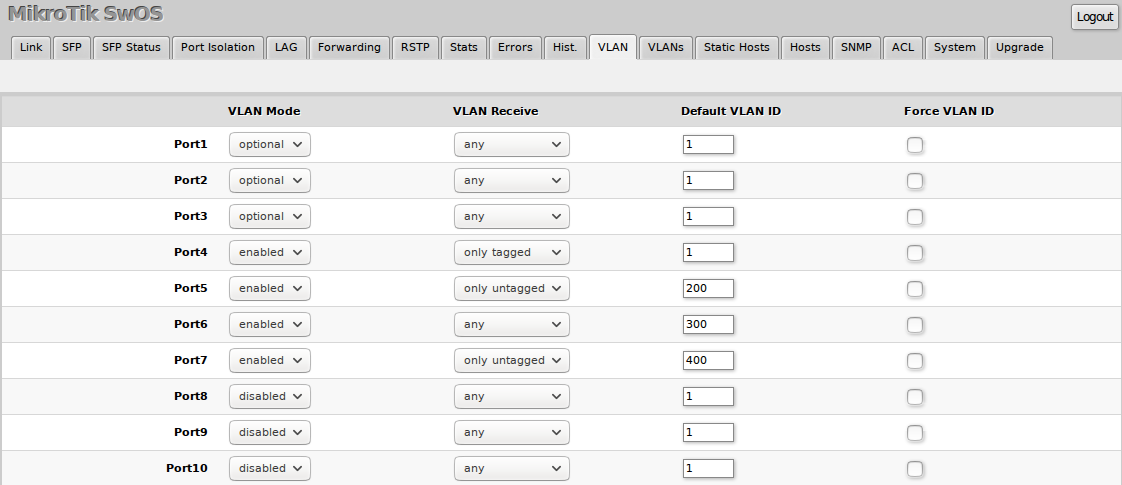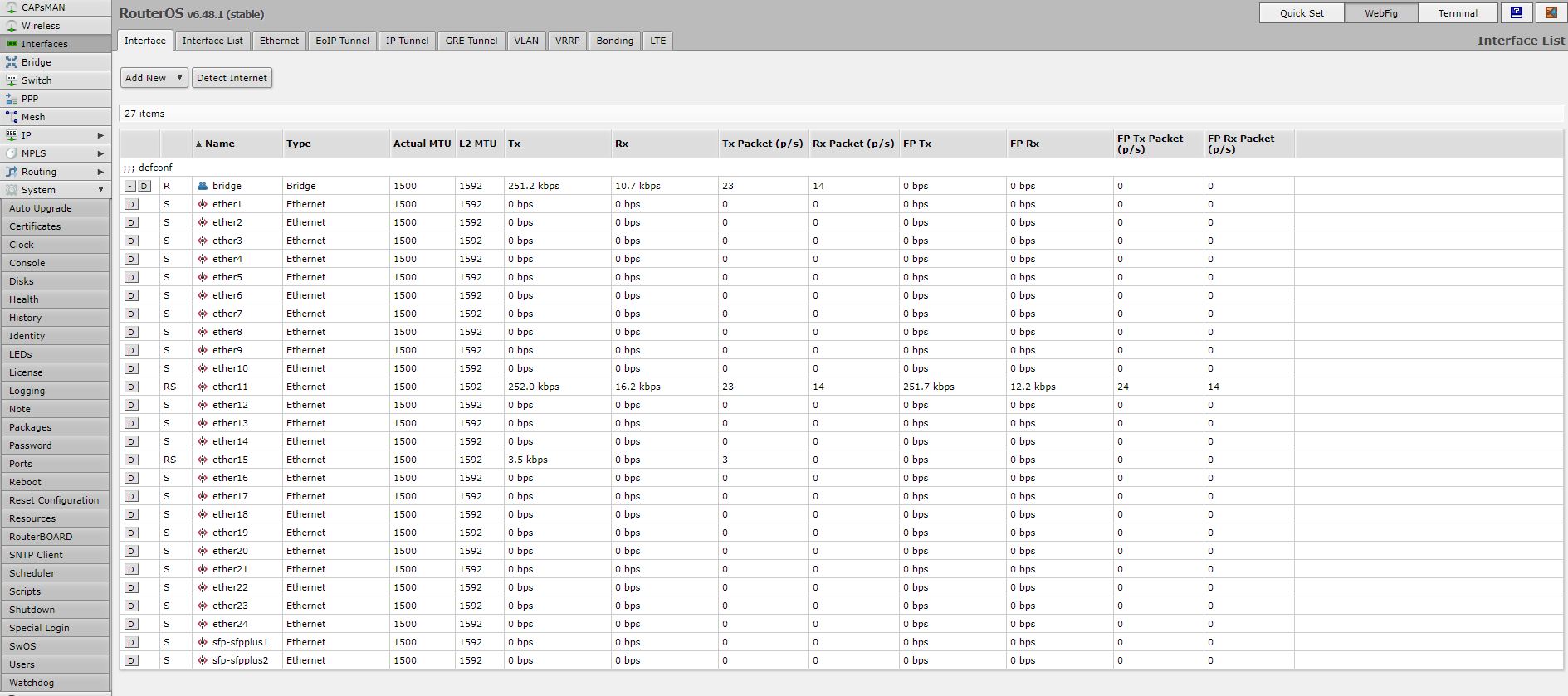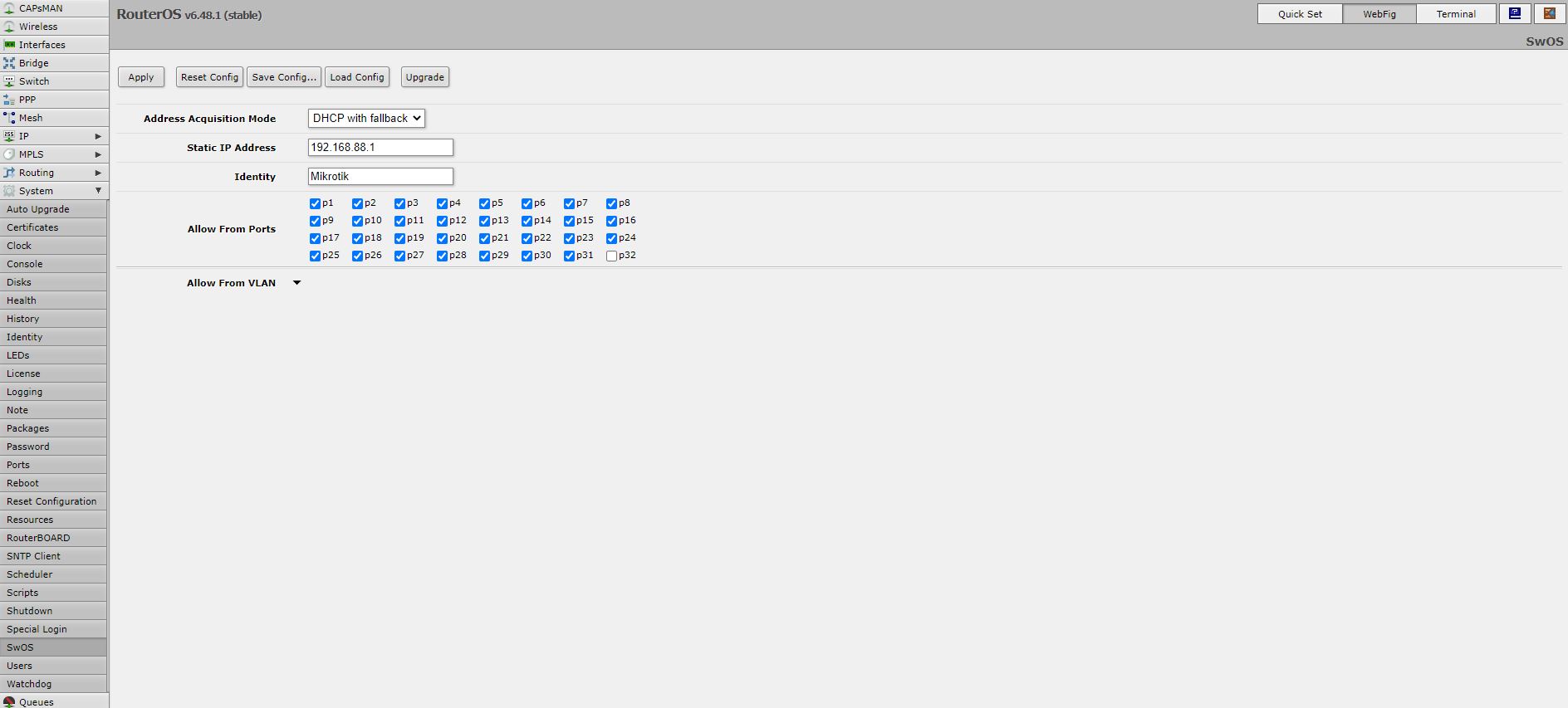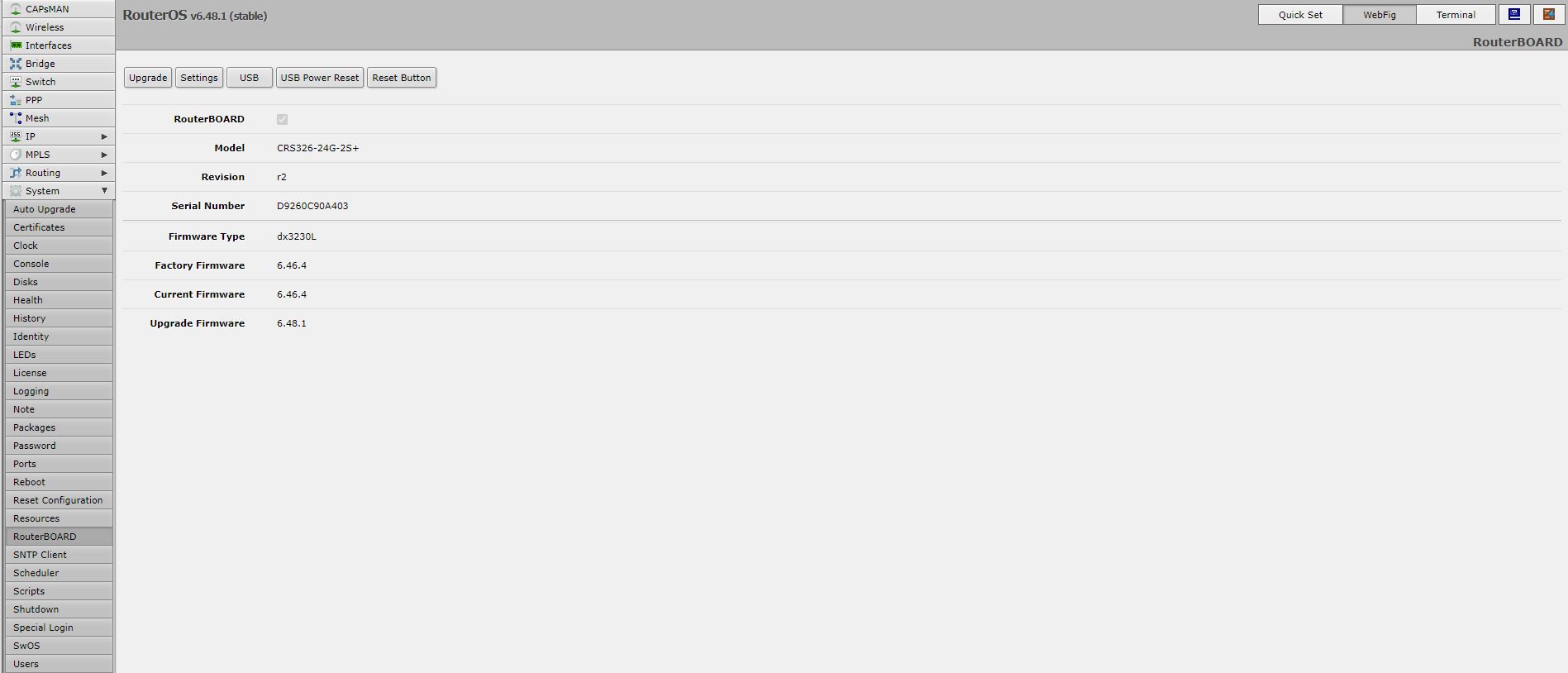MikroTik CRS326-24G-2S+IN Management
Overall, one can use a number of different methods to manage the MikroTik switches. One can use WinBox, the company’s Windows client, the CLI that can be accessed through a number of channels, or the WebFig management. We are going to focus on a few screenshots from the WebFig here.
The other major aspect of the CRS326-24G-2S+IN is OS. Technically, this switch can be used with MikroTik’s SwitchOS (or SwOS.) At the same time, we also get the ability to use the company’s higher-end RouterOS with a level 5 license. SwitchOS is the company’s simplified switch-centric offering, while RouterOS is the company’s platform used across most of its portfolio. For most of STH’s readers, RouterOS is the better choice for this switch. In simplifying SwOS, the company has removed many features. SwOS is also a more niche platform for MikroTik so it tends to run into more bugs than one may expect on RouterOS from our experience. Here is a look at SwOS from the MikroTik CSS326-24G-2S+RM which is a SwOS-only product:

Generally, we prefer RouterOS. This adds to cost, but it is usually worth it when you hit a SwOS limitation. The CRS326-24G-2S+IN ships with RouterOS as its default, with the option to run SwOS.

RouterOS was built for the company’s routers. Technically, one can run VPN or a firewall on the switch. There are practical limitations with the single-core Arm CPU so we generally advise against this. Also, one can add features such as creating multiple bridges on the switch, however, only one bridge is hardware accelerated. The key takeaway is that there is a lot of functionality in RouterOS, but that functionality one should not necessarily expect will be hardware accelerated and thus operate at line-rate.

We wanted to point out that these $189 products are often entries into the MikroTik realm for users. Here, we somewhat see why SwOS is important because one can see artifacts of different functions that are not as applicable to the switch. For example, here is the System -> SwOS page. A new user that navigates to this page would need to spend some time understanding what it is since there is effectively no contextual help.

One can also notice artifacts in the terms “Wireless” on the switch without wireless features, or the mention of “USB” when there is not a USB port on the unit. Further, there are screens like this one that show running on RouterOS v6.48.1 (stable) in the header. Factory Firmware is 6.46.4 so one can see the upgrade. Yet, when one looks to “Current Firmware” the 6.46.4 is still listed with the upgrade firmware of v6.48.1. To a new user, this can be extremely confusing.

RouterOS has a lot of functionality, but we understand why some may prefer SwOS given that the complexity level is high on RouterOS. We are just going to mention that as one may expect on a $189 switch if you have an issue with the software, you are not going to be able to call up 24x7x365 and get support from MikroTik. This is an area where MikroTik has a lot of functionality, but if you are accustomed to high-end and high-functionality Juniper, Cisco, or Arista switches the support processes are very different.
A Word on Competition
There are other low-cost 24-port switches out there. In this section, we are going to discuss the closest competitors we could find because the market context is a big deal here. Many products we review are sold on a per-deal or corporate discount basis. These are often purchased at retail. We are going to discuss pricing and port counts, but then this section will have Amazon affiliate ads that pull current pricing. You can choose not to use them, but as an Amazon affiliate STH may earn a small commission if you use those links. The benefit is that they update pricing for this article on a near-real-time basis.
For example, the ZyXEL GS1900-24 is only about $130 when discounts are run. MikroTik has a more robust feature set and instead of there being two SFP ports, we get SFP+ ports. To us, we like the ability to uplink at 10GbE speeds.
Like the ZyXEL, the Ubiquiti UniFi Switch 24 USW-24 is around $225 direct and also has 24x 1GbE and 2x SFP (not SFP+) ports.
Likewise, Cisco has the SG350-28 with 24x 1GbE and 4x SFP and that often goes on sale for only $230:
TP-Link has a T1600G-28TS that is only $130 with 24x 1GbE and 4x SFP ports.
TrendNET has the TEG-30284 which is around $280 and is 24x 1GbE plus 4x SFP+.
The Netgear GC728X is around $260 and is 24x 1GbE plus 2x SFP and 2x SFP+.
Here is the latest pricing for the MikroTik CRS326-24G-2S+IN for reference. Usually this is lower than the $189 list price:
The key takeaway here is that in 2015 when the CRS226-24G-2S+IN was launched we were raving about how revolutionary a ~$300 switch was with that feature set. Now, even at a ~35% lower cost we would still call this a low-price leader, but not by the same margin we would have six years ago. The market has changed in this segment.
We also want to quickly mention that if you are not looking for this exact port configuration, then MikroTik offers a fairly wide line of switches. We have reviewed many of them on STH. At a little more than twice the price, for example, one can get a MikroTik CRS326-24S+2Q+RM featuring 24x SFP+ and 2x QSFP+ ports or the 48x 1GbE, 4x SFP+ 2x QSFP+ MikroTik CRS354-48G-4S+2Q+RM. For a lower-cost, if you just want to use SwOS, one can get the MikroTik CSS326-24G-2S+RM. There are many options to scale up and down from this switch, so if it does not exactly fit your needs, then it may be worth evaluating other models.
Next, we are going to look at performance and power consumption before getting to our final words.




The price on Amazon is currently around $120 (depending on vendor and their trustworthiness). This is so close to the price for the CRS326-24G-2S+RM ($185) as to hardly justify the reduced cost of the reviewed CRS326-24G-2S+IN unless one is looking for other specific features, such as portability/size or power usage.
I’d like to see a CRS326-24G-4S+RM (i.e., 4x SFP+) or even 6x SFP+ instead of the 2x SFP+ with the available unit. I am not inclined to the PoE version with 4x SFP+, and for home lab use 4x or more SFP+ ports would be helpful. Granted there are dedicated 4x SFP+ and 9x SFP+ units, but that drives the cost up having two units.
it’s a great solution… if you still need that many slow 1GbE ports.
what was a great lineup of low-cost 1GbE and SFP+ lineup years ago, now seems dated.
there are just a few units with QSFP and zero with nbaset or even more outlandish 10gbe…
I got really excited that they released a case painted red :D
I’m confused by the author’s claim that 10GbE has “peaked and is now in decline”. What is he referring to? Is this about a specific port or 10GbE as such? I don’t understand how 10GbE can be viewed as in decline. It hasn’t even peaked yet in homes, since it’s quite rare still. A lot of business contexts will be just now getting around to 10GbE, or the new 2.5 and 5 Gbps standards, to back Wi-Fi 6E APs and what have you.
I’m also stumped by this passage:
“The key takeaway is that there is a lot of functionality in RouterOS, but that functionality one should not necessarily expect will be hardware accelerated and thus operate at line-rate.”
Is the author saying that this functionality is not hardware accelerated, or that it is? Which functionality? And how does hardware acceleration work in this context, with these Mikrotik switches? So is there an ASIC or FPGA chip in there, in addition to the Arm core? How do they integrate it, or is it already put there by Marvel?
I’m impressed with what Mikrotik can do with hardware that I wouldn’t have expected to be powerful enough. You can power a switch like this with one obsolete Arm core? That’s amazing. I guess I don’t understand what the compute requirements are for this class of switch. They must be very low. An oldish dual core Intel Celeron built on their 22nm node would be an absolute beast compared to this single 32-bit Arm core. A low-end smartphone SoC would also be several times as powerful.
@Joe The CPU only runs the OS, essentially. The switching itself is done in hardware. This is essentially how all switches work.
I just bought RM version andit have CPU coller. Newest batches will have it.
One thing to note – I searched the article for it, but couldn’t find any mention – ff you think SSL is a must have for the management interface, this switch is not for you! Apparently they only have 64KB for their SwOS image, so it is unlikely to change soon and probably impossible for this product line. SNMP also only supports insecure v1 protocol. Only telnet, no SSH support. SNMPv1 and no SSH are OK for this price I think, but what the hell – no SSL?
I’m hoping to upgrade my home network to gear with 10g support, but even at this low price I can’t bring myself to buy something with only 2 10g ports and the rest are 1g. I think the ideal point needs to be 2.5g network (or at least a handful of ports that are 2.5?) and 4 10g SPF+ ports. That will let you connect your faster equipment (including >1g internet which is becoming more common), like a primary workstation, storage array, uplink to additional switches, and internet, to the 10g ports, and still have >1G available for the devices that need it. Otherwise with only 2 10g-capable ports, once you connect your >1g internet and storage, everything else you connect is still stuck at 1G speeds, and that just doesn’t justify the upgrade.